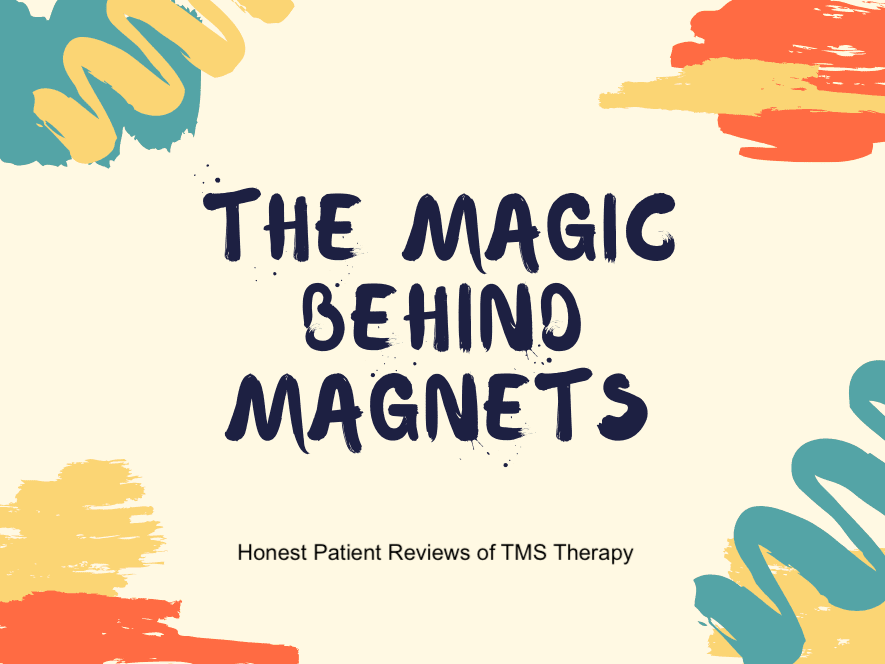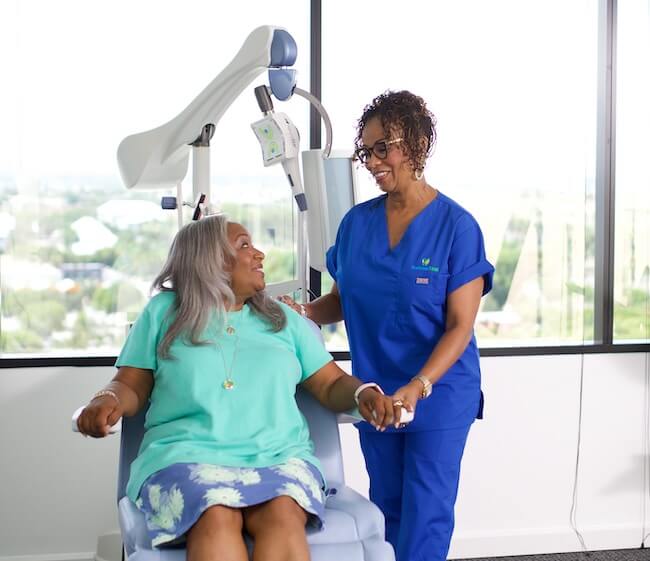Medically reviewed by Dr. Lindsay Israel.
Looking for authentic TMS therapy reviews?
As a top-rated TMS provider in America, we, Success TMS, know a thing or two about delivering amazing patient care.
Yes, we have over 1000 reviews but we wanted to share a few personal experiences below.
Want to get a feeling of what TMS Therapy is all about?
Let’s get started…
OVERVIEW
– TMS Therapy Reviews
– How TMS Therapy Feels
– TMS vs Medication
– What is TMS Therapy?
– Why Try TMS Therapy?
So here goes nothing. Our TMS review / overview.
TMS Therapy Reviews From Patients
1) Alexia’s TMS Review
My name is Alexia,
I’ve suffered from really bad anxiety my whole life.
When I talked to therapists about it, I felt like they didn’t always take me very seriously. And when I tried taking medications, it was just disastrous. I experienced the worst side effects. I gained 30 pounds.
So I started doing a lot of research, and I found Success TMS. And now that I’ve started with Success TMS, I feel like I don’t have so many lows during my day or during my week, during my life, in my experiences.
And I think one of the aspects of the treatment that is more difficult is that you have to come every single day for a relatively long period of time, not too long, but it’s a commitment to do TMS.
And I definitely look forward to coming to treatment every day because of the staff here. I would say to anyone who’s suffering with severe depression, anxiety, and who is losing their sense of hope to not give up.
When I started, before I came to Success TMS, I was in a really low place, where I felt really hopeless. And in a lot of ways, Success TMS was kind of what I was telling myself was my last hope. And luckily, it worked.
I would recommend that everyone try Success TMS because, at worst-case scenario, there would be no change, but at best-case scenario, it would be completely life-altering in a positive way.
And that’s what my experience with the treatment has been, is that I’ve experienced a level of calm with my anxiety, and stability and contentment with as far as my depression goes that I haven’t experienced in a really long time.
So I would definitely recommend Success TMS to anyone who’s losing hope.
Success TMS has been my hope.
2) Cheryl’s TMS Review
I’m Cheryl, I’ve been suffering from depression for 20 years.
Being on medication was draining. Because of my depression, I couldn’t remember if I had taken the dosage.
After going through TMS I realized why was probably because I couldn’t, my memory from taking the medicine was taken, I believe.
I had come off all medication for 2 months prior to TMS and I got to that point where I was going to get back on it or something else and i was tired of switching medicines.
So I really started reading the pamphlets that they had given me and I immediately called my husband and it was a Monday morning and I said we need to call this place back and we did and it was the best thing I could have ever done.
By my 7th visit, I could sleep at night, I could make dinners again, I was becoming more in flow with everyday life.
I would suggest anyone to contact Success TMS. Thank you Success TMS for this new way of life you.
3) Chelsea’s TMS Review
Hi, my name is Chelsea and I suffered with anxiety and depression for the last 10 years.
Living with depression was very scary and lonely I felt trapped in my own mind.
I’ve been on medication since I was 20 years old I’ve been on a host of different medications.
Prior to starting TMS, my grandma who’s actually a therapist up north told us about TMS so we started doing research and that’s when I came across Success TMS and took the plunge to get help.
Since completing my treatment at Success TMS, I feel like a whole new person. I don’t feel like I’m trapped in my mind, I feel free.
My treater barbara was amazing. I actually did not start out with her, but then I had a schedule change, so they put me with her. I was a little hesitant at first but I grew to love her and trust her and even my little sister, like to this day, still asks about her.
If you’re suffering from depression I would say to reach out to success TMS because it’s changed my life for the better. Thank you Success TMS
4) Lauren’s TMS Review
My name’s Lauren and I’ve suffered from depression for 28 years.
Before I found Success TMS, my life had become totally unmanageable.
Being on antidepressants for me I always felt like I was in a fog.
I had a hard time dealing with the side effects of antidepressants. They seem to be much worse than the small positives I got out of antidepressants.
Before I completed my treatment with Success TMS, or had even started it, my daughters noticed that I was always angry all the time yelling cursing.
Since completing my treatment I have gotten my life back.
Just to hear my kids and my parents say hey we got our old Lauren back. It’s brought me so much joy just to be able to be myself and work through things and not have to rely on a medication that I don’t know what’s going to make me feel like.
At the end of the day, I couldn’t believe the final outcome because I came in in tears and I left with a huge smile on my face.
Thank you Success TMS for giving me my life back.
How Does TMS Feel?
The feeling of TMS is described by patients in the video below.
They describe TMS to be annoying for the first few sessions, not painful, weird, and even relaxing depending on the patient’s experience.
Watch patients describe exactly how TMS feels in this video.
TMS VS Prescription Medication
We’ve become very comfortable with the idea of modern medicine having a quick fix for whatever ailment we’re suffering from today.
What if there was an answer that didn’t include putting more substances into your body?
If you’re interested in getting the full picture, see how TMS compares to Medications here.
You’re probably well versed in the unending list of unpleasant side effects that come along with the cocktail of drugs.
Anything for the chance to swap them out with an alternative that didn’t make you feel like a shadow of yourself, right?
Now you can with TMS Therapy.
What is TMS Therapy?
TMS or Transcranial Magnetic Stimulation is a non-invasive, FDA-Cleared, non-med treatment for Depression and other mental health conditions with no systemic side effects.
TMS is also covered by insurance. Most insurance providers in the U.S. cover TMS therapy. Medicare also covers TMS which means over 300 million Americans are covered. Medicaid covers TMS in some states like New Jersey.
TMS uses MRI strength magnets to stimulate a specific area of the brain (prefrontal cortex) that is underactive in people with depression.
Patients sit comfortably in a chair and TMS is administered by a certified treater.
1 session lasts roughly 18 minutes and it takes 6-8 weeks of treatments.
Before treatments ever begin, a mapping is conducted which isolates the exact treatment area and appropriate pulse strength. Once the mapping is complete you’ll be sure that all future sessions provide accurate and effective TMS treatments.
TMS therapy has been approved in the U.S. to treat Major Depressive Disorder (MDD), anxiety, migraines, OCD, smoking cessation; however, it’s in the trial stages for so much more like weight loss, bipolar disorder to autism to even help with post-stroke physical therapy outcomes.
Why Try TMS Therapy?
If you’ve tried medication and seen few positive results, TMS might be for you.
If the side effects of the medication have become too much, TMS might be for you.
If you’ve had enough of medication and would like to try a treatment that’s proven more effective than meds, TMS might be for you.
Have questions? We, Success TMS, are here to help!
Find a location near you or contact our team at 888-406-9648.
Now It’s Your Turn
Did this post answer your questions? Was anything missing? We’d love to hear from you. Comment below.






1 Comment
This sounds very promising, I hate taking pills that either makes me feel like a zombie or makes me sleep all the time.
I recommend this TMS treatment for every person who suffers with depression. I have it completed the six weeks of treatment on December 2020 and I started to feel better before I ended the six weeks. The professionals who took care of me where sensitive and gentle, they helped you the whole process. They made you feel welcome and caring about your improvement. I suffered from depression for fourteen years and taking many different antidepressants; many of them the sides effects were worst than the depression, but right now my psychiatrist lowest the amount of pills and I feel much better due my success with the TMS. I wish you the best and Believe in my review.